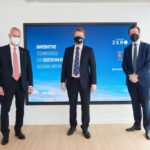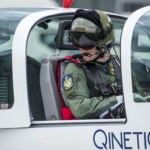Rolls-Royce and international management consultancy Roland Berger have released a market study into the potential of the Advanced Air Mobility Market (AAM) for the APAC* region.
The report looks into the benefits of passenger all-electric Vertical Take-Off and Landing (VTOL) aircraft, known as ‘air taxis’ which can be used for urban and regional air mobility. This includes city taxi or airport shuttle routes and intercity flights of up to 250 km.
The study also highlights the importance of government, industry and regulators working together to develop the regulation, infrastructure and societal change needed to deliver the many economic and environmental benefits that AAM offers. The study found the new emerging market could deliver $36.9bn of service revenue alone across the APAC region by 2050.
Study forecasts 16,400 VTOL in Japan by 2050
The urban geographies of the cities of Singapore, Tokyo and Seoul mean the APAC region could lead the way in advanced air mobility by offering time-saving and more convenient travel which could bring downtown, suburbs and tourist attractions closer together. The study estimates that 16,400 passenger VTOL aircraft could be in operation in Japan, worth around $14.3 billion service revenue, by 2050, with South Korea offering the commercial potential of $3.8 billion and Singapore $350 million, in under three decades.
Rob Watson, President – Electrical, Rolls-Royce, said: “The Advanced Air Mobility market is incredibly exciting, offering the opportunity to transform the way we travel. This market study with Roland Berger demonstrates the commercial potential of the APAC region and how the region could lead the way in introducing all-electric passenger services. Rolls-Royce is at the forefront of developing and delivering all-electric and hybrid-electric propulsion systems that will enable passengers to travel sustainably and help deliver net zero carbon by 2050.”
Key findings of the report are:
- · From the global AAM market, the APAC region could account for more than half of all operated eVTOL aircraft and over 40 per cent of global revenue by 2050
- · 82,500 AAM aircraft could be in operation in the APAC region by 2050, with an estimated $36.9bn of service revenue
- · Market forecasts show APAC countries implementing AAM services before 2030, with the potential of over a thousand of aircraft by 2030
- · Frontrunner cities, like Singapore, Tokyo or Seoul have the opportunity to orchestrate the implementation of the AAM ecosystem to deliver this exciting market for the future
- · AAM is already becoming reality in the APAC region, with interesting partnerships and airline activities announced in frontrunner cities
“Whole new ecosystem of new business opportunities”
Manfred Hader, Senior Partner and Global Head of Aerospace & Defence, Roland Berger, added: “A whole new ecosystem with new business opportunities will emerge as AAM becomes a reality.”
Rolls-Royce is offering customers a complete electric and hybrid-electric power and propulsion system for their platform. Solutions are under development for electric vertical take-off and landing (eVTOL), electric short take-off/landing (eSTOL) and electric fixed-wing commuter aircraft supported by a specialised team based in Singapore as part of the global Rolls-Royce Electrical business. Rolls-Royce is collaborating with Vertical Aerospace for the electrical technology that will power their eVTOL aircraft. Vertical Aerospace has already announced pre-orders from customers in the region.
Rolls-Royce and airframer Tecnam are currently working with Widerøe, the largest regional airline in Scandinavia, to deliver an all-electric passenger aircraft for the commuter market. Beyond that, Rolls-Royce will leverage its existing capabilities to deliver maintenance services for the emerging AAM industry and together with Rolls-Royce Power Systems will look to provide charging and energy infrastructure for airports and vertiports.
Rolls-Royce is committed to ensuring its new products will be compatible with net zero operation by 2030 and all its products will be compatible with net zero by 2050.
* APAC region consists of 25 countries for this market study: Australia, Bangladesh, Cambodia, China, India, Indonesia, Iran, Iraq, Japan, Kazakhstan, Laos, Malaysia, Myanmar, New Zealand, Pakistan, Philippines, Russia, Singapore, South Korea, Sri Lanka, Taiwan, Thailand, Turkmenistan, Uzbekistan, Vietnam

